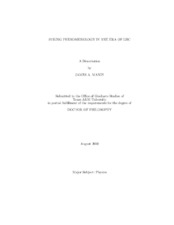| dc.description.abstract | The low-energy supersymmetry phenomenology for specific classes of string compactifications is investigated given that the low-energy physics may provide a clue as
to the structure of the fundamental theory at high energy scales. The one-parameter
model (OPM), a highly constrained subset of minimal Supergravity where all the
soft-supersymmetry breaking terms may be fixed in terms of the gaugino mass, is
studied, in addition to a three-family Pati-Salam model constructed from intersecting D6-branes. Furthermore, the phenomenology of gravity mediated supersymmetry
breaking F-theory SU(5) and SO(10) models, as well as F-SU(5) models with vector-
like particles, are examined. We determine the viable parameter space that satisfies
all the latest experimental constraints, including the most recent WMAP relic neutralino abundance observations, and find it to be consistent with the CDMS II and
other concurrent direct-detection experiments. Moreover, we compute the gamma-ray
flux and cross-sections of neutralino annihilations into gamma-rays and compare to
the published Fermi-LAT satellite telescope measurements. In F-theory SU(5) and
SO(10) models, we predict the exact small deviation of the gaugino mass relation at
two-loop level near the electroweak scale, which can be tested at the colliders. More-
over, in F-SU(5), we predict the precise deviations from the mSUGRA gaugino mass
relations due to the presence of the vector-like particles, also testable at the colliders.
The compilation of all these results form a comprehensive collection of predictions
with which to evaluate these string models alongside anticipated experimental dis-
coveries in the coming decade. | en |


